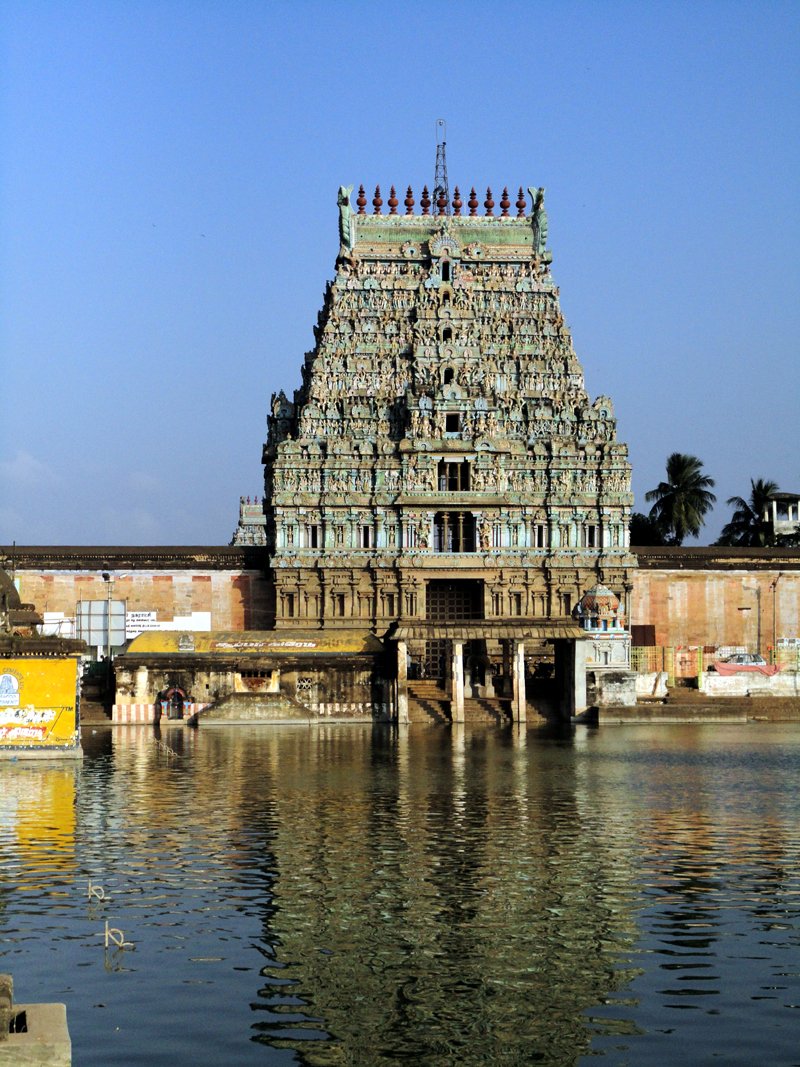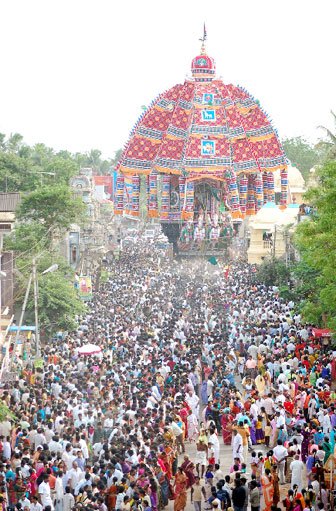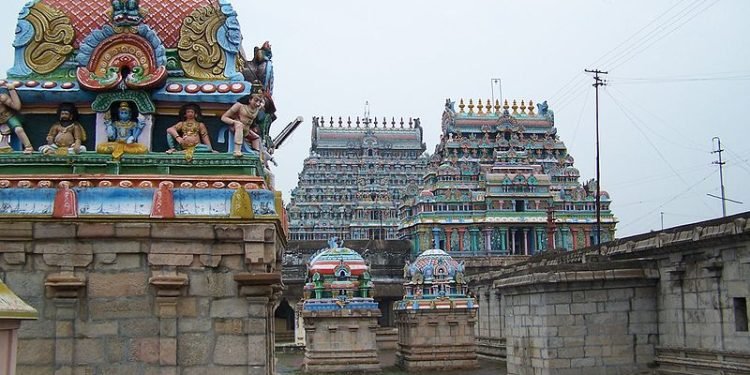Thyagaragar Temple is a Hindu temple dedicated to the deity Shiva, located in the town of Thiruvarur in Tamil Nadu, India. Shiva is worshipped as Moolanathar and is represented by the lingam. Daily poojas are offered to his idol referred to as Maragatha lingam. His consort Parvathi is depicted as Kondi. The presiding deity is revered in the 7th century Tamil Saiva canonical work, the Tevaram, written by Tamil saint poets known as the nayanars and classified as Paadal Petra Sthalam.
Shrine’s History
The temple dates back to the time of the Medieval Cholas.An inscription dated in the 20th regnal year of Rajendra I beginning with an introduction “Tirumanni valara” is found on the north and west walls of the Thyagaraja shrine.It gives a list of gifts including a number of jewels and lamps to the god veedhividankar.It records that the temple was built in stone in the regnal years of the king by Anukkiyar Paravai Nangaiyar.Besides the same lady liberally endowed gold for plating and gilding parts of the vimana, the entrance and the four sides of the shrine.Copper was also donated for plating the doors, corbels of the pillars of the mandapa in front of the shrine.
This inscription meticulously records the weight of the endowed gold and copper, besides listing the various ornaments gifted to the temple with description each of them. The temple complex seems to have acted as the cultural model for the big Brahadeeswarar temple at Thanjavur of Rajaraja Chola I, wherein he enshrined a vitankar which shared with the Atavallan of Chidambaram the status of state cult. The last Chola monarch to play an important role in the affairs of the temple was Kulothunga Chola III in the early part of the 13th century A.D. It attracted saivas of all schools and was the important centre of Golaki matha in the 13th and 14th century. It was also an important Jaina dwelling place, which was attacked by saivas, as is evident from Periya Puranam, an account of a life of tantiyadigal.


Architectural Relevance of This Shrine
The temples complex occupies an area of around 33 acres with the Kamalalayam tank to its west. There are numerous shrines and mandapas in the three spacious enclosures. The two main shrines of the temple are for vanmikinathar and Thyagarajar. Of the two, the former is the most ancient and derives its name from the anthill, which takes the place of linga in the main shrine. Appar, the 7th-century poet saint, refers to the main deity in his hymn as puttritrukondan. The Stala vriksham is patiri. The principles and practises of tree-worship and ophilotary are ancient bases whereupon a later date linga worship seems to have been established. Here all the 9 Navagrahams located towards the south in the straight line also located in north-west corner of 1st. This temple holds the record of having a maximum number of shrines in India. The foot of Thyagaraja is shown twice a year and on other occasions, it is covered with flowers.
The left leg of the deity is displayed during “panguniuthram” festival and right leg on “thiruvathirai”. Some of the major shrines in the temple are of Aananthiswarar, Neelothmbal, Asaleswarar, Adageswarar, Varuneswarar, Annamalieswarar and Kamalambal. The temple has a lot of halls, with six of them being the most prominent. Bhaktha Katchi hall is located to the left of the image of Moosukuntha Nandi. The festival image of Thyagaraja arrives at this hall after the Panguni Uthiram festival.
Oonjal hall is located opposite to the Kabatha Katchi hall. The festival images of Chandrasekarar and Sekari Amman arrive at this hall during the Thiruvadhirai festival. Thulapara hall is named after the legend in which king Mucundaka placed Thyagaraja image of Thiruvarur in one and all others in another plate he received from Indra (the king of celestial deities). Purana hall is located in the northern part of the temple. Rajanarayana hall is a public hall for localities of Thiruvaru. Rajendra Chola hall, also called Sababathi hall houses the museum of the temple
Shrine’s Map Location and How to Go There
By Road
The nearest Bus stop is Thiruvarur
By Rail
The nearest Railway Station is Thiruvarur Junction.Thiruvarur is well connected to other major cities of the country via regular trains.
By Air
The nearest Airport is Tiruchirappalli.
Shrine Timings
5.00 a.m. to 12.00 a.m. and 4.00 p.m. to 9.00 p.m.
Events Celebrated at This Shrine
Margazhi Tiruvadhirai in December-January, Lord Thiagesar granting His Feet darshan Pada Darshan; 10 day Panguni Uthiraim in March-April with the flag hoisting on the Hastha Star Day of the previous Tamil month Masi, with car festival on the 10th day with the significance of the darshan granted to sage Vyakrapada; 10 day Aadi Pooram in July-August; the Bhoodha Ganas carrying paddy bags to Saint Sundararar on Masi Magam Day in February-March; Chithiria festival in April-May are the important festivals of the temple. Besides the above, the Pradosha Puja are devotionally performed drawing huge crowds. Deepavali, Pongal the Makar Sankranthi, Tamil and English New Year days are also observed with special pujas.













































